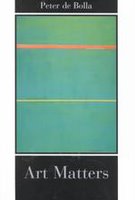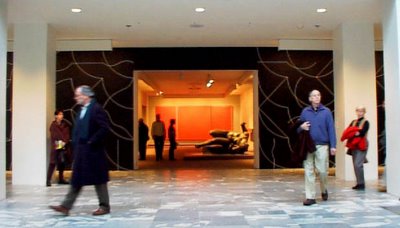 "It occurs to me," Peter de Bolla writes in Art Matters, "that closing one's eyes the better to see is no bad thing" (52). Later, de Bolla will suggest we "close our ears" the better to hear (81). Aesthetic appreciation cannot be reduced to a single sense: it must be affective; it must be tactile. Indeed, the aesthetic is here defined precisely as an affective response to a work of art. And art? Art is any object that provokes such affect, since "the quality of being 'art' lies not, in any sense susceptible of description or analysis, in the object but in the response it elicits" (18).
"It occurs to me," Peter de Bolla writes in Art Matters, "that closing one's eyes the better to see is no bad thing" (52). Later, de Bolla will suggest we "close our ears" the better to hear (81). Aesthetic appreciation cannot be reduced to a single sense: it must be affective; it must be tactile. Indeed, the aesthetic is here defined precisely as an affective response to a work of art. And art? Art is any object that provokes such affect, since "the quality of being 'art' lies not, in any sense susceptible of description or analysis, in the object but in the response it elicits" (18).Yet de Bolla's book concentrates, too predictably, on "high" art and, what is more, on "difficult" art: Marc Quinn's Self; Barnett Newman's Vir Heroicus Sublimis; a Glenn Gould performance of Bach's Goldberg Variations; and William Wordsworth's "We Are Seven." De Bolla states that to have chosen otherwise would have been to pander to the "politically correct" or to fashionability (132). And these difficult works have been stepping stones in his "own ongoing aesthetic education" (21). Might it not, however, have been illuminating--not simply tokenism--to have asked what one learns, about "high" art as much as about "low," from a rock concert or a sports game?
De Bolla makes the democratic gesture of admitting that the "simple, trivial, or roughly worked up" can provoke a "strong" or "deep" affective, and so aesthetic, response. But, as his chapter titles indicate, there are certain forms of strength, certain modes of depth, that de Bolla favours over others: "Serenity"; "Clarity"; "Equanimity"; and "Fragility." A limited palette, no? He has, in short, other criteria for aesthetic evaluation that he is less keen to articulate. And though he avoids using the term, surely these criteria come under the rubric of "Refinement."
For despite its absence from these pages, the concept of refinement is suggested immediately that the "simple" or "trivial" are equated with the "roughly worked up." It is also present in the book's emphasis on preparation: "How can one prepare for art?" (24). And it is, further, insistently indicated in the stress de Bolla puts on aesthetic appreciation as hard work, "hard won" (130). For is not refinement the work of preparation that transforms the rough hewn into a commodity fit for "civilized" use, be that commodity oil or sugar, art or aesthete.
And I wouldn't be the first to observe that Sir Henry Tate's transfer of capital from the sugar business to the art business was merely another refining process, another purification, a laundering of money still reeking of blood and slave labour in Caribbean plantations.
De Bolla, however, wants to excise all traces of the social from his account of aesthetics: it is not that history, ideology, and so on do not matter, he tells us; it is that they are not properly aesthetic aspects of the artwork. But such an excision is more easily said than done. And rather than continue to berate the book for its attempts to repress the social and historical, it is more worthwhile to focus on the points at which they return.
For though the book's grand narrative ends up being "the slow but finally telling realization of the acceptance of solitude" (145), its most interesting and persuasive chapter tells a rather different story. This is de Bolla's account of Barnett Newman's Vir Heroicus Sublimis, a work that is (as de Bolla himself notes) inescapably public.

De Bolla argues that the size and scale of Newman's painting, the fact that there can never be any one good position from which it can be viewed,
demands that the viewer resist a particular form of looking, traverse the reflective stare of looking at oneself looking in order to enter a shared space in which the nakedness of presentation asks one to face up to being here, in the visibility of a communally constructed presence. (40)De Bolla goes on to term this "the hushed sublimity of a shared world" (40), but I'm at a loss to see why it should be hushed, and also believe that we can resist this "vir heroicus"'s construction of sublimity.
Why not the noisy immanence of a shared world?
It's true that New York's Museum of Modern Art, in which this canvas is hung (and in which it has to be hung, in that it's clearly unsuitable for private possession), is a secular temple to the aesthetic. But it's also one of the most-visited museums in the world, a bustling frenzy of school parties, tourists, and day trippers. If this painting incites "the presentation of the body to vision--and not just my body, but the somatic in general, the social body constructed in the practice of viewing in public" (41), why should we accede to what de Bolla himself terms the "virtual effect of transcendence" (28)?
To put this another way: the affective (for de Bolla, therefore, aesthetic) experience that this painting evokes is necessarily social. It is, in this sense, indeed dehumanizing, both in that it undoes the subjective mastery of the humanist individual, and in that what de Bolla rightly notes as its timeliness, its sense "of being in the moment, of being now" (45), makes a mockery of those overdetermined narratives invoking some Western "shared culture [. . .] shared humanity" (28). Before this painting, in this museum, we are bodies in motion: our relation to each other is affective rather than simply cognitive; in fact, our sense of our distinctiveness is dissolved, if only slightly, in the wonderment and distraction, attentive inattention, that de Bolla (again, convincingly) argues is the domain of the aesthetic.
Here art is a catalyst for unrefinement: mixing up what had previously been separated out; accepting, indeed welcoming, impurity.
Cannot the aesthetic then be considered, not merely as a mode of bondage in the machine age, but also as an experience of rapport suitable for an age still to come? This is where a trip to a concert or the football might have been instructive.
In the meantime, we should note that sublimity and sovereignty are not merely virtual effects. They're secured by the guard lurking around the corner...

No comments:
Post a Comment